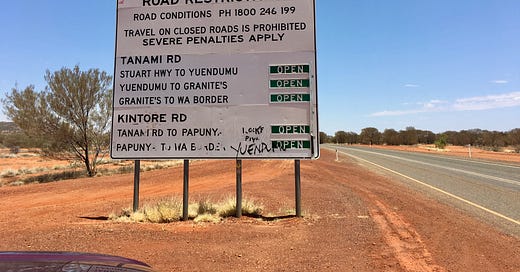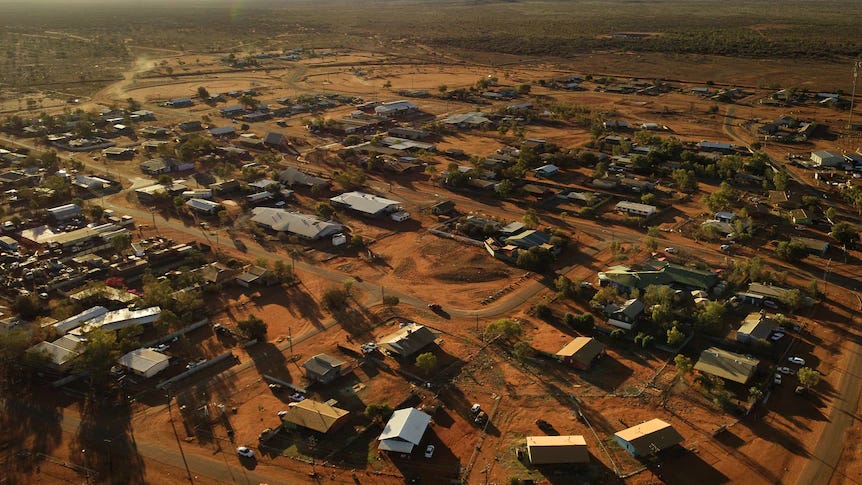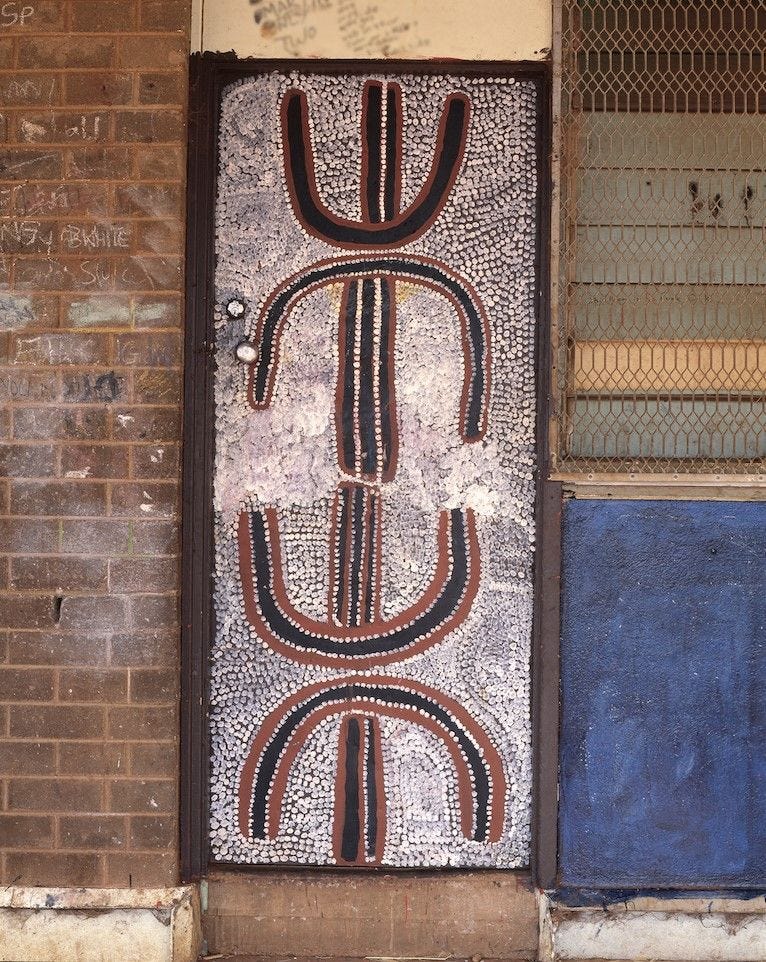The thing you learn from 3 bowsers and some cakes at the Big Shop
Letter #17 - Alice Springs to Mount Doreen via Yuendumu
G’day!
Welcome to Letters From the Road, and letter number 17. Thanks for joining me in my little letter writing campaign and giving me a reason to write my version of what-I-did-on-summer-vacation.
For those of you for whom this is your first letter, welcome! Good on ya for reading. Letters From the Road is the story of a family road trip in Australia, told one weekly installment at a time featuring my journal entries written during the trip. You’ll see the journal entries highlighted in the letter.
If you’ve just joined us and want to catch up, you can find the other 16 letters here, painted onto a door.
And on to your letter.
Luke
25 October 2019, Mount Doreen Ruins
Departing civilisation, if you can call Alice that.
Relatively speaking, though, it’s a goddamn metropolis, compared to anywhere we will be in the next 10 days. The Tanami Desert lies ahead.
Leaving Alice Springs marked a big departure, not only because we had been in Alice for four nights, the longest we’d stayed anywhere since we were stranded in Coober Pedy. We would also be leaving the Stuart Highway, a road we’d been travelling north on for what seemed like our entire trip, leaving it to head west: across the Tanami Desert, through the Kimberley, all the way to the west coast and a paradise called Broome.
My letter to you today is written around one of the shorter journal entries from our trip, one that’s just a bit over 100 words. But this, our 25th day on the road, remains one that I think about a lot, one that opened my eyes to some things that are an unmistakable part of the landscape in this part of Australia.
This was one of the first times I really took notice and thought about Australia. The whole thing, good and bad. What it is and, more importantly, who it is. It would be impossible to tell the story of Aboriginal people in Australia in a letter, so I’m not going to try. And I’m probably not the right person to do so anyways.
I can only tell you what I thought and I felt at the time, what I got wrong, what I’ve learned since then. We were confronted with the reality of things, literally drove straight into it, without knowing what we were driving into. I thought Yuendumu, a remote town of 759 people in the Tanami Desert, would be just another country town. It was one of the few places along our route that sold fuel, and we needed diesel.
I’ll try to make sense of this by telling you a story. I can almost hear my boys yelling at me from the backseat, something along the lines of ‘We already know this!’, so apologies if this letter has fallen into the hands of any Australian primary school kids. Let’s go back 250 years ago. In 1770, Lieutenant James Cook sailed the HMS Endeavour up the east coast of Australia, what was known at the time as New Holland.
Cook is a bit of a hero in Australia. There’s a statue of him in Sydney’s Hyde Park that bears an inscription saying that Cook discovered the territory in 1770, but that’s actually not the case. A Dutch navigator named Willem Janszoon first came across Australia in 1606, thus the reason it was known as ‘New Holland’ in the first place. Of course there’s the small fact that Europeans in boats did not discover Australia at all, because there is evidence of people occupying Australia that dates back almost 50,000 years.
50,000 years that Indigenous people - the First Nations, as they are also referred to - have been living all across Australia, from the coast around Sydney, to the red centre where we were travelling, all the way to the far reaches of the west coast. One of the hallmarks of Indigenous Australians is their respect for the land, and a lifestyle that prioritises living in balance with their surroundings and the environment. I’d like to think this is part of the reason why they were able to do pretty well for themselves for 50,000 years.
Cook himself seems to have observed the same in his encounters with the Aboriginal peoples on the coast. In the journals from his 1770 voyage, Cook wrote:
From what I have said of the Natives of New Holland they may appear to some to be the most wretched people upon earth, but in reality they are far more happier than we Europeans; being wholy unacquainted not only with the superfluous but the necessary conveniencies so much sought after in Europe, they are happy in not knowing the use of them. They live in a Tranquillity which is not disturb’d by the Inequality of the Condition
Cook’s grievous misspellings aside, he made a keen observation. Sure, he was saying, the natives don’t look like us, and don’t have our fancy clothes and stately manors and huge ships plying the oceans, but they don’t seem to miss any of it.
Cook was sailing west as part of a scientific mission, and also to search for a hypothetical great southern continent that was referred to as ‘Terra Australis’, so he was not in the area to colonise or claim new lands. Nonetheless, after charting much of Australia’s east coast, Cook conveniently ignored the presence of the Indigenous people and claimed much of the east coast of Australia for the King, including a part that he named ‘New South Wales’.
Here’s a bit more history that’s well travelled. In 1788, 18 years after Cook departed Australia, what’s known as the First Fleet - eleven ships with nearly 1,500 people aboard - arrived in Botany Bay and what would become Sydney. They arrived with the goal of establishing a penal colony. The day they found a suitable place to land, 26 January 1788, is still celebrated as Australia Day.
This is the point when 50,000 years of harmony bumped up against the cruel inertia of time. It’s also the point in our story when my understanding of Indigenous Australians bumped up against the inertia of history and ignorance. I could easily retreat to the comfort of the fact that I grew up in the U.S., so why would I know the details of what’s happened to Indigenous Australians over the last 250 years?
History is only made up of the things that we know, the things that we write, the things that we tell ourselves. The plaques we read, the books they choose to give us in school. That statue to Cook is but one example, and the plaque saying he discovered New South Wales.
Another comes from a memory I have of being in Hobart, the capital of Tasmania, and seeing the statue of a guy named William Crowther. The inscription on the plaque under the bearded bronze of Crowther standing straight and tall and looking throughtfully off into the distance, reads, ‘Erected by a grateful public, and sincere personal friends, to perpetuate the memory of long and zealous political and professional services rendered in this colony’.
William Crowther was an early premier of Tasmania, the kind of thing that might net you a statue. He was also, and this didn’t make the plaque (probably because the words were written by his wife), known to have stolen the head from a deceased Aboriginal man named William Lanne, who was considered the last ‘full-blooded’ Tasmanian Aboriginal man. Crowther removed Lanne’s skull, replaced it with that of some other poor bugger whose name is lost to time, then mailed it to the Royal College of Surgeons in London. I’m not sure if that is what’s meant by ‘zealous political and professional services rendered’.
The lessons to be learned here are clear: First, always have your loving wife write the words on your monument. Second, that history is made up by how someone has chosen to tell the stories from the past. So maybe I have good cause to claim ignorance? Ignorance is bliss, as they say, and I’m a happy guy in most cases. But I’d prefer not to. I’d prefer to think about it with you on the other end of this letter. I’d prefer to try and fill in the gaps with things that I didn’t know at the time. And there’s a lot I didn’t know.
I didn’t know that there’s a good chance that the First Fleet brought with it smallpox and other diseases that decimated the native population who had no resistance to such things.
I didn’t know about the protectionist movement of the mid-1800’s, a philosophy that Aboriginals were a dying people and needed to be protected. This led to forcibly moving native peoples to missions, reserves, and stations, where their work, dress, education and movements were controlled by a white ‘protector’.
I didn’t know that this led to what’s referred to as the ‘stolen generation’, children being taken from their parents in the name of protection, and that the laws allowing this remained in place until 1969.
I didn’t know that the government was stealing lands from native peoples as recently as the 60’s using the principle of ‘terra nullius’, that the land is empty, uninhabited, and that this is the same principle used in the 1700’s to justify Britain claiming Australia as its own.
I didn’t know about the massacres.
I didn’t know these things, but they were all right there, in Yuendumu, a place where we were planning to stop for a few minutes and fill up the tanks. Here’s what I wrote at the time.
Drove through Yuendumu, a trashy place. Ok cakes from the Big Shop. Why are all the teachers and people working at the store not Indigenous? Why was the girl working at the servo in Hermannsburg a French girl?
The roads in and around Yuendumu are mostly made from red dirt, or look to be red dirt because the desert is trying to reclaim the space from the bitumen. The small, single story tin roofed houses are surrounded by yards of red, most with fences to keep people out, dogs in. There’s no grass, and only a few trees.
Yuendumu was founded in 1946 as one of many reserves created by the government. It’s located 300km (186 miles) from the eastern end of the Tanami Track, and not far from the spot where something called the Coniston Massacre took place. In 1928, between 100 and 200 local people were killed in retaliation for the suspected killing of a white man by Aboriginals.
Yuendumu is a place with problems, a bit of trash on the side of the road being the least of it. There aren’t enough jobs, and yet the school teachers I saw and the people running the store were white people, which suggest that the system is broken somehow - something else I don’t understand.
But Yuendumu’s got spirit. When we pulled up to the local store - the Big Shop, they call it - school had just let out, and there were kids running all round and bringing lots of energy to what could very easily have been a sad and desolate place.
Three bowsers sit outside the store, locked securely in a cage that can only be unlocked by requesting access from the white cashier inside. The petrol protector. There’s no self service here.
Yuendumu also has art. A group of local elders famously painted 30 doors of the local school with traditional Dreamtime designs, as a way to help teach local kids about traditional culture. The doors were later removed and went on tour around Asia before landing in the South Australian Museum. We couldn’t find the local gallery on our way out of town, so instead drove away quietly, our windows closed and air conditioning pumping, headed back to the Tanami Track.
Something else I didn’t know at the time - couldn’t have known - was that around two weeks after we left town, a 19-year old Yuendumu resident named Kumanjayi Walker was shot and killed in his home by a white policeman named Zachary Rolfe. Police were looking for Walker in connection with some criminal activity, and apparently Walker stabbed Rolfe in the shoulder with scissors before he was shot. After the shooting, police removed the body to the police station and locked the doors until they and the body could be flown to Alice Springs. Rolfe was charged with murder, but aquitted. The incident spawned a Black Lives Matter movement in the area, and there’s a coronial inquest - basically an investigation into the department, the systems, and factors that led to the shooting - that is still ongoing as I write this. Sounds familiar, no?
30 minutes for some fuel and cakes left an impression. Places like Yuendumu leave you with plenty to think about, and if there’s one thing you can count on when driving across the desert is that you’ll have plenty of time to think.
We drove for another 2 hours after leaving Yuendumu, and even at that we were no closer to being close to anything. One of the benefits of being in the middle of the desert is that you can camp more or less anywhere you please. So we pulled off when we spotted a tiny track leading off to the north.
Dark clouds were starting to roll in as we drove down the track, looking for a decent place to set up for the night. After a few moments, we started to come across signs of civilization, a cattle station called Mount Doreen. We passed the shells of old cars, buildings, metal sheds. Sheet metal lay curled on the ground like discarded orange peels thrown from the window of your car. Some of the buildings were skeletons, where only the walls and a few pieces of metal window frame remained. Some were razed all the way to the flat slab of concrete, with no signs of the rest of the bones. It all looked ancient, but in some ways like there might have been someone there yesterday. We wondered - who had lived here? How long ago? Might they come back?
The boys thought the place creepy. I didn’t disagree, so we drove on down the track.
A little further on, at the base of a rocky hill, and we got out to investigate a flat spot that looked like it might make a decent spot to set up camp, until we noticed what appeared to be the dried out husk of a dead cow. I’ve camped in some terrible spots in my time. There was the time I camped in a ditch at the bottom of a small hill, only to wake up during a rainstorm, submerged in water. I slept in the open air on the concrete slab of a warehouse loading dock. But I draw the line on sleeping amongst mummies, farm animals or otherwise. The ruins of Mount Doreen were the lesser of two evils, delightful in comparison.
We got back in the car, turned around, and headed back the way we came, settling on the flat slab of a long gone building for our camp.
The clouds continued to roll through, thick and gray, with breaks every now and then that would create tricks with the light from the sun that was quickly growing low in the sky. This did nothing to improve the gloomy atmosphere.
Mount Doreen - strange place, crazy weather. Took a half, sat by our fire made in a half oil drum with Katie. She kept asking me what all the bright stars are, along with other questions I couldn’t answer.
Henry was scared. Kept seeing lights in the sky. I saw some weird lights too.
Out on the wastes of the Never Never
- That's where the dead men lie!
There where the heat-waves dance forever
-That's where the dead men lie!
Barcoft Boake, Where the Dead Men Lie
There are many more kilometres of the Never Never still to come, and possibly dead men too, as we continue onward through the desert. Next stop, a place called Wolfe Creek, and its well known link to a serial killer named Ivan.







